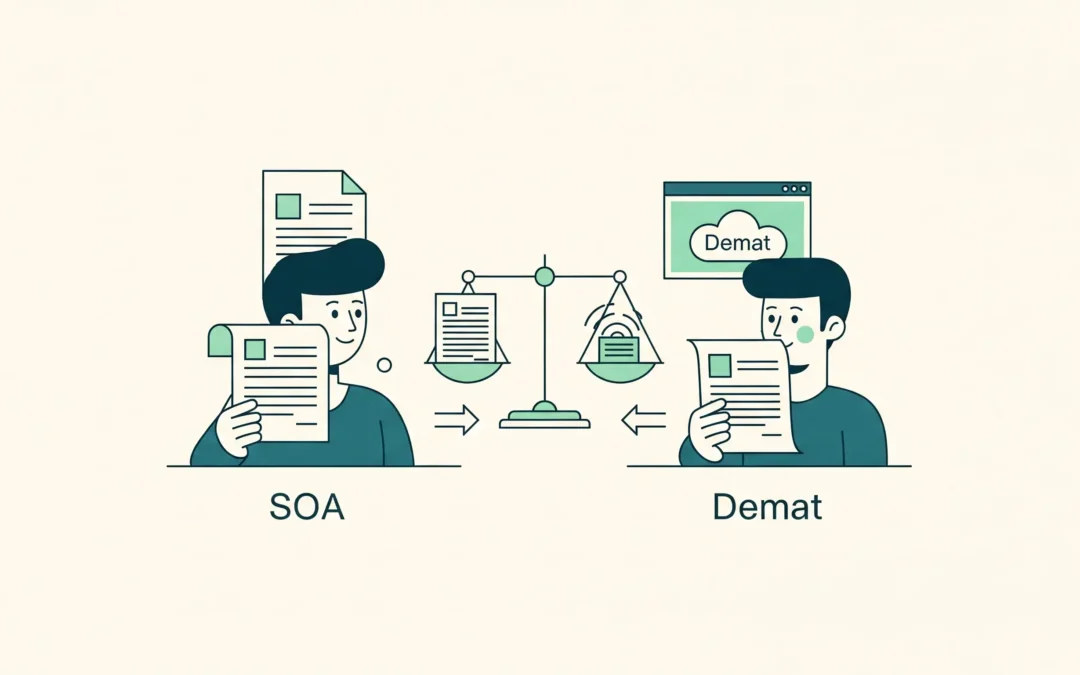Many mutual fund investors think that a demat account is the only way in which they can begin investing in mutual funds. But this is not the case. SOA, or statement of account, is another trusted way in which investors can invest their money and earn returns with fewer complications. Sounds good, right? But is it suitable for everyone?
This article will help you understand SOA in detail, along with providing a comparison with a demat account to find which one suits you best.
What is a Statement of Account (SOA)?
The mutual fund company issues a digital document called a Statement of Account (SOA), which contains information about your investment, including the number of units, NAV, transaction history, and more. If you invest with an AMC (Asset Management Company), distributor, or app, this is the default way to hold mutual funds. It is easy to use, cost-free, and popular among Indian retail investors.
Key Features:
- To begin investing, you do not need a Demat account.
- No yearly or maintenance fees.
- Units of mutual funds are kept in an electronic format.
- The AMC, KFintech, or CAMS issues the statement.
- Easy to track using apps like Kuvera and Paytm Money, which support SOA holdings; some apps, like Groww for mutual funds, need a demat account, so check before investing.
- Generally safe, as most platforms require KYC and OTP, but security depends on the service, not the SOA mode itself.
- Most of the time, redemption processing is faster.
What is a Demat Account?
Similar to a digital wallet, a Demat (Dematerialised) account contains a variety of electronic securities, including stocks, bonds, mutual funds, and exchange-traded funds (ETFs). Although stock trading requires it, many investors also use it to hold mutual funds so they can manage all of their investments in one location. This account must be opened through a Depository Participant, such as ICICI Direct, Upstox, or Zerodha.
Key Features:
- Centralised repository for mutual funds, stocks, and ETFs.
- For individuals who are already stock market investors, this is convenient.
- You can manage joint holdings and, for eligible schemes, pledge or transfer units, though not all mutual funds allow this, and extra steps may apply.
- It involves yearly maintenance fees, which are usually between Rs. 300 and Rs. 700.
- You and your broker can view your portfolio on a single dashboard.
- Processing redemptions is a little slower because the depository is involved.
- Strong security is ensured by being regulated by either CDSL or NSDL.
SOA vs. Demat: Which One is Better?
Now that we know the meaning and features of both, let us find out which one is better:
Suitability of SOA
- First-time investors looking for an easy and affordable way to invest in mutual funds should consider SOA.
- Those who prefer apps like Kuvera or Paytm Money, which let you hold mutual funds in SOA mode, rather than brokers needing a demat account.
- The goal of SIP (Systematic Investment Plan) investors was to build wealth over the long run.
- Investors who desire easier access to account statements and speedier redemptions through platforms such as KFintech or CAMS.
- Those who are unwilling to pay for or keep up a Demat account.
Suitability of Demat
- Investors in the stock market who wish to combine mutual funds in one location and already have a Demat account.
- Investors are searching for a single dashboard to monitor all securities, including mutual funds, stocks, bonds, and exchange-traded funds (ETFs).
- Those wanting to jointly manage, or for some funds, pledge or transfer units, can use the demat mode, though these features have some restrictions.
- Those who feel at ease using brokers such as ICICI Direct, Groww (stocks), Upstox, Zerodha, etc.
- Users who are prepared to pay yearly maintenance fees in exchange for more centralisation and convenience.
| Investor Type | Recommended Option | Reason |
| New mutual fund investor | SOA | Zero charges, easy to use, app-friendly |
| Stock market active user | Demat | One platform for all investments, easier tracking |
| SIP-focused long-term investor | SOA | Faster redemption, simpler reports |
| Portfolio consolidator | Demat | Seamless transferability and integration with stocks |
Bottomline
The conclusion can be drawn that both SOA and demat accounts are suitable for different sets of investors. Choosing the best can be subjective, based on the investing style and preference. However, if you are a beginner and want to start by investing in mutual funds, SOA is your way to go. But if you are already in the stock market, making trades, then a demat account might be more suitable and convenient for you.


